A low-fat diet focuses on reducing dietary fat intake to promote weight management and improve health outcomes․ It emphasizes natural, unprocessed foods like fruits, vegetables, and whole grains․
What is a Low-Fat Diet?
A low-fat diet is a dietary approach that emphasizes reducing the intake of fats, particularly saturated and trans fats, to promote better health and weight management․ It focuses on natural, unprocessed foods such as fruits, vegetables, whole grains, and lean proteins․ The diet encourages avoiding high-fat foods like fried items, processed snacks, and red meats․ By limiting fat intake, it helps lower calorie consumption and reduces the risk of chronic conditions like heart disease․ This eating plan is tailored to support overall well-being while maintaining a balanced and nutritious intake of essential nutrients․
Benefits of a Low-Fat Diet
A low-fat diet offers numerous health benefits, including weight management, improved heart health, and reduced risk of chronic diseases․ By cutting down on saturated fats, it helps lower cholesterol levels and blood pressure, minimizing the risk of heart disease․ This diet also aids in controlling blood sugar levels, reducing the risk of type 2 diabetes․ Additionally, it promotes a feeling of fullness, making it easier to maintain a healthy weight․ Overall, a low-fat diet supports long-term well-being by focusing on nutrient-rich, unprocessed foods that provide essential vitamins and minerals while keeping calorie and fat intake in check․
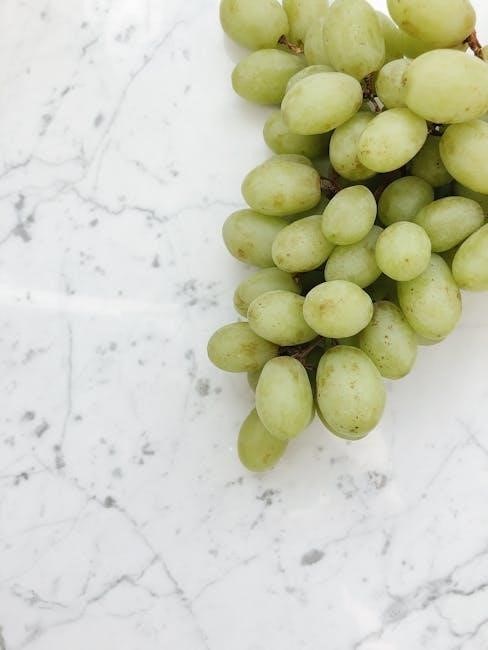
Food Groups in a Low-Fat Diet
A low-fat diet encompasses diverse food groups, emphasizing fruits, vegetables, whole grains, lean proteins, and low-fat dairy․ These groups provide essential nutrients while minimizing fat intake․
Fruits and Vegetables
Fruits and vegetables are cornerstone components of a low-fat diet, offering natural sweetness, fiber, and essential vitamins․ They are inherently low in fat and calories, making them ideal for weight management․ Fresh, frozen, or canned options without added sugars or salts are recommended․ Leafy greens like spinach and kale, cruciferous vegetables like broccoli, and vibrant fruits such as berries and citrus are particularly beneficial․ These foods not only support overall health but also help reduce the risk of chronic diseases like heart disease and diabetes․ Incorporating a variety ensures a balanced intake of nutrients․
Whole Grains
Whole grains are a fundamental part of a low-fat diet, providing essential nutrients, fiber, and energy․ They are naturally low in fat and rich in complex carbohydrates, which help maintain a healthy weight and improve digestion․ Examples include oats, brown rice, quinoa, whole wheat bread, and barley․ These grains are often fortified with vitamins and minerals, making them a nutrient-dense choice․ Incorporating whole grains helps lower cholesterol levels and reduces the risk of heart disease․ They also support blood sugar control, making them an excellent option for overall health and wellness․ Opting for whole grains over refined alternatives is a smart dietary choice․
Protein Sources
Protein sources are essential in a low-fat diet, providing the body with necessary amino acids while maintaining a healthy fat intake․ Lean meats like poultry and turkey, without the skin, are excellent choices․ Fish and seafood, such as salmon and cod, offer high-quality protein and beneficial omega-3 fatty acids․ Plant-based options like legumes, beans, tofu, and lentils are also rich in protein and naturally low in fat․ Eggs and low-fat dairy products, such as yogurt and milk, are additional protein sources that fit well into a low-fat diet․ These foods help maintain muscle mass and overall health without excessive fat consumption․
Dairy Products
Dairy products can be part of a low-fat diet when chosen wisely․ Opt for skim milk, low-fat cheese, and nonfat yogurt to reduce saturated fat intake․ These options provide essential nutrients like calcium and protein without excessive fat․ Avoid whole milk, cream, and full-fat cheeses․ Portion control is key, even for low-fat varieties․ Reading nutrition labels helps identify products with minimal fat content․ Incorporating these dairy products supports overall health while aligning with low-fat dietary goals․ They also contribute to a balanced diet by offering versatility in meals and snacks․ Choose wisely to reap the benefits without compromising your low-fat regimen․
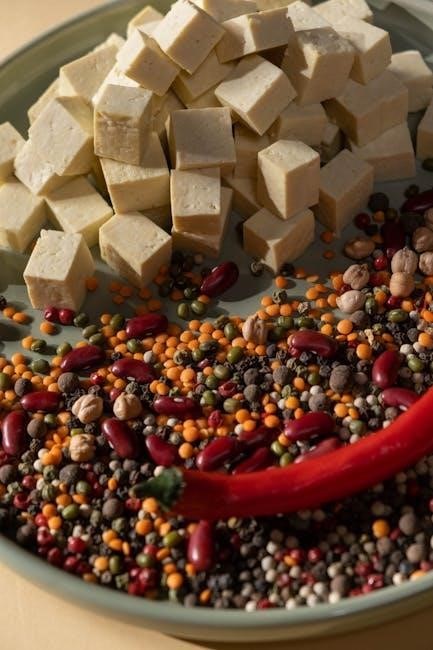
Healthy Fats
While emphasizing low-fat intake, healthy fats remain essential for a balanced diet․ Avocados, nuts, and seeds are rich in monounsaturated and polyunsaturated fats, which support heart health and satisfy hunger․ Olive oil, used in moderation, enhances meals without excessive calories․ Fatty fish like salmon provide omega-3 fatty acids, crucial for brain function and inflammation reduction․ Even on a low-fat diet, incorporating these fats in controlled portions ensures nutrient adequacy and overall well-being․ They add flavor and variety, making meals more enjoyable while supporting long-term health goals․ Always choose unsaturated over saturated fats to maximize benefits and minimize potential risks․
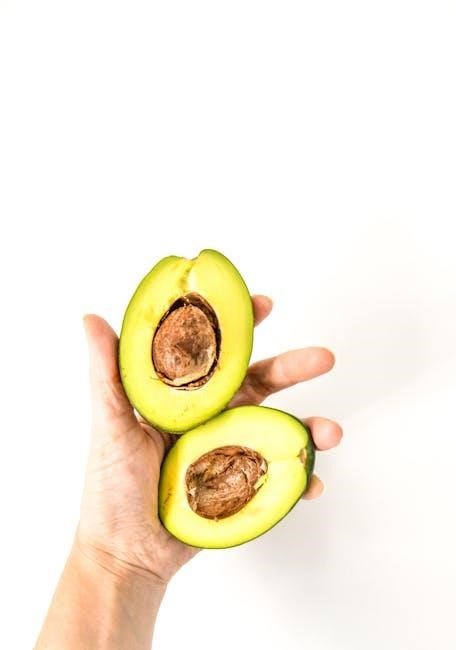
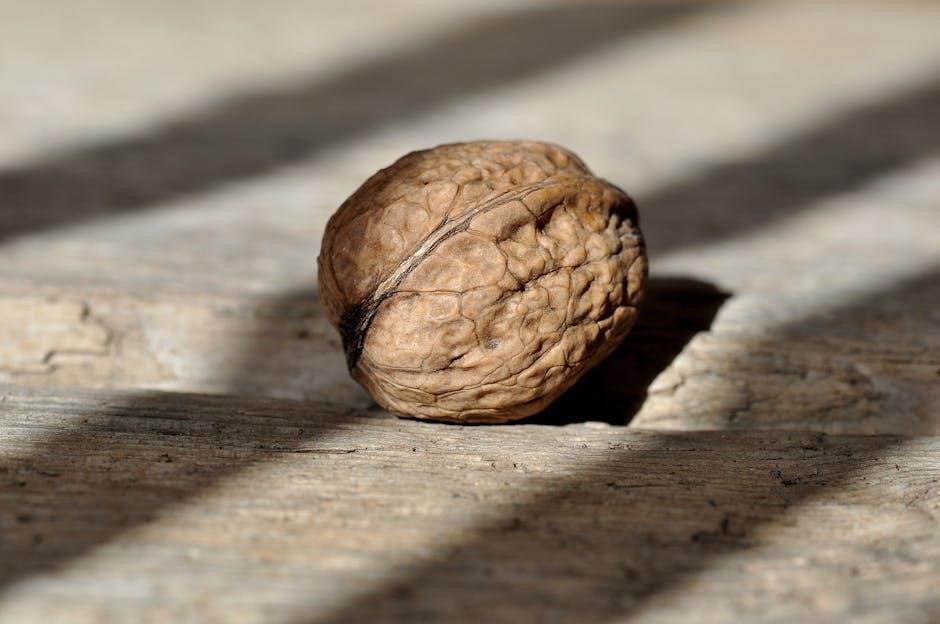
Foods to Include in a Low-Fat Diet
A low-fat diet emphasizes whole, unprocessed foods like fruits, vegetables, whole grains, lean proteins, and low-fat dairy․ These provide essential nutrients and satiety․
Lean Meats
Lean meats are excellent protein sources in a low-fat diet․ Opt for cuts with visible fat trimmed, such as chicken breast, turkey, or lean beef․ Avoid processed options like sausages․ Fish and poultry are ideal, providing essential nutrients without excess fat․ Grill, bake, or steam these meats to keep them healthy․ Portion control is key to maintaining a balanced intake of protein and fat․ Always choose fresh over processed to maximize nutritional benefits and minimize fat content․
Fish and Seafood
Fish and seafood are excellent additions to a low-fat diet, offering lean protein and essential nutrients․ Opt for fatty fish like salmon, mackerel, and albacore tuna, which are rich in omega-3 fatty acids․ These fish support heart health and reduce inflammation․ Choose baking, grilling, or steaming to avoid adding extra fat․ Avoid fried seafood, as it significantly increases calorie and fat content․ Shrimp, cod, and tilapia are great low-fat options․ Incorporate a variety of fish and seafood into your meals for a balanced and nutritious diet․ Always prioritize fresh, unprocessed options to reap the most health benefits․
Low-fat dairy products are rich in calcium and protein while being low in saturated fats․ Skim milk, nonfat yogurt, and reduced-fat cheeses are excellent choices․ These options help maintain strong bones and muscles without excessive calorie intake․ Opt for lactose-free or fortified varieties for added nutritional benefits․ Avoid whole milk, cream, and full-fat cheeses, as they contain higher levels of saturated fats․ Incorporating low-fat dairy into meals can improve overall health and support weight management․ Always check nutrition labels to ensure products align with your dietary goals․ Nuts and seeds are nutrient-rich additions to a low-fat diet, offering healthy fats, protein, and fiber․ Opt for unsalted, unsweetened varieties like almonds, walnuts, chia seeds, and flaxseeds․ These provide essential omega-3 fatty acids and antioxidants․ However, portion control is crucial due to their calorie density․ Avoid fried or sugar-coated options, which are high in unhealthy fats and added sugars․ Incorporate them as snacks or sprinkle on meals for added crunch and nutrition․ They support heart health and satiety, making them a beneficial inclusion in a balanced low-fat diet․ Always choose natural forms to maximize health benefits․ Plant-based foods are a cornerstone of a low-fat diet, offering a wealth of nutrients with minimal fat․ Options like legumes, lentils, and beans provide protein and fiber while keeping fat content low․ Tofu and tempeh are excellent protein sources with minimal fat․ Whole grains such as quinoa, brown rice, and oats are also ideal, offering sustained energy․ Incorporate a variety of colorful vegetables and legumes into meals to ensure a balanced intake of vitamins and minerals․ These foods not only support heart health but also aid in weight management and reduce the risk of chronic diseases․ They are versatile and nutritious․ Avoid processed, fried, and high-fat foods like red meat, full-fat dairy, and sugary snacks․ These contribute to excess fat and calories, hindering weight goals․ Processed foods are often high in unhealthy fats, added sugars, and sodium․ They include items like frozen meals, snacks, and ready-to-eat products․ These foods typically contain artificial additives and preservatives that can negatively impact health․ Examples include fried chips, baked goods, and pre-packaged meals; Many processed foods are designed to be convenient but often lack essential nutrients․ Opting for whole, unprocessed foods instead can help maintain a balanced diet and reduce overall fat intake․ Always check nutrition labels to identify and limit processed foods high in saturated or trans fats, which can increase cholesterol levels and heart disease risk․ Fried foods are typically high in fat due to the cooking process, which involves submerging food in oil․ Examples include french fries, doughnuts, and fried chicken․ These foods are often rich in calories and saturated fats, contributing to weight gain and heart disease․ Fried foods can also contain harmful compounds like trans fats, which increase cholesterol levels․ To maintain a low-fat diet, it’s essential to limit or avoid fried foods․ Instead, opt for baking, grilling, or steaming to prepare healthier versions of your favorite dishes․ This approach reduces fat intake while preserving flavor and nutritional value․ Always choose healthier cooking methods․ High-fat snacks, such as potato chips, cheese puffs, and chocolate bars, are calorie-dense and can hinder weight management․ They often contain saturated fats, which may raise cholesterol levels and increase heart disease risk․ These snacks are typically processed and lack essential nutrients, making them an unhealthy choice․ Incorporating high-fat snacks into your diet can lead to excessive fat consumption, complicating efforts to maintain a balanced low-fat diet․ It’s crucial to identify and avoid such snacks to achieve better health outcomes and adhere to dietary goals․ Opt for fresh fruits, nuts, or low-fat alternatives instead to satisfy cravings without compromising health․ Always prioritize nutrient-rich options․ Red meat is typically high in saturated fats, which can increase cholesterol levels and contribute to heart disease․ Limiting or avoiding red meat is often recommended in a low-fat diet․ Opting for leaner cuts and smaller portions can help reduce fat intake․ Additionally, trimming visible fat from meats before cooking can further lower their fat content․ Choosing plant-based protein sources or lean poultry as alternatives to red meat supports a healthier dietary approach․ Moderation is key, but for those aiming to minimize fat consumption, reducing red meat intake is generally advisable․ This helps maintain overall dietary balance and promotes better cardiovascular health․ Low-fat cooking methods like grilling, roasting, and steaming help retain flavor without adding extra fat․ These techniques ensure meals are nutritious and delicious, supporting a healthy diet․ Grilling and roasting are excellent cooking methods for a low-fat diet as they require minimal added fat․ These techniques enhance flavor naturally through caramelization and char without extra oils․ For grilling, foods like lean meats, fish, and vegetables are ideal․ Roasting brings out the natural sweetness in foods, making them tasty without added fats․ Both methods preserve nutrients and texture, ensuring meals are healthy and satisfying․ Always trim visible fat from meats before cooking to keep dishes low in fat․ Season with herbs and spices for added flavor without calories, making grilling and roasting versatile and healthy choices for any meal․ Steaming and poaching are low-fat cooking methods that preserve nutrients and flavors without adding extra fat․ Steaming uses steam to cook food, making it ideal for vegetables, fish, and poultry․ It retains vitamins and minerals, ensuring a healthy meal․ Poaching involves cooking in liquid, such as water or broth, and is great for delicate foods like eggs, fish, and fruits․ Both methods are gentle, preventing the loss of essential nutrients․ They are perfect for a low-fat diet as they require no oils or butter, keeping meals light and nutritious while maintaining taste and texture․ Baking and stir-frying are excellent cooking methods for a low-fat diet․ Baking uses minimal oil and works well for meats, fish, and vegetables, allowing natural flavors to shine․ Stir-frying quickly cooks ingredients in a small amount of oil, preserving crispiness and nutrients․ Both methods are versatile, suitable for a variety of dishes․ They help maintain the nutritional value of food while keeping fat content low․ Incorporating these techniques into meal preparation supports a balanced and healthy diet without compromising on taste or variety․ These methods are ideal for those aiming to reduce fat intake while enjoying flavorful meals․ Effective meal planning ensures balanced nutrition and adherence to a low-fat diet․ Plan weekly meals, shop for fresh ingredients, and prep healthy options to avoid impulsive choices․ Starting your day with a nutritious, low-fat breakfast sets the tone for healthy eating․ Opt for oatmeal topped with fresh berries and a drizzle of honey․ Whole-grain toast with avocado or a scramble using egg whites and spinach makes for a satisfying start․ Greek yogurt paired with sliced bananas and a sprinkle of chia seeds is another excellent option․ Smoothies blending low-fat milk, spinach, and tropical fruits are quick and refreshing․ Incorporate lean proteins like turkey bacon or a tofu scramble to keep you full longer․ Remember to choose whole-grain cereals and pair them with low-fat milk for a balanced meal․ For a satisfying and healthy low-fat lunch, consider grilled chicken or turkey wraps using whole-grain tortillas and loaded with crisp vegetables like lettuce, cucumbers, and bell peppers․ A hearty quinoa or brown rice salad with chickpeas, cherry tomatoes, and a light vinaigrette is another great option․ Lentil or vegetable soup paired with a side of steamed greens makes for a nutritious and filling meal․ Opt for baked or poached fish served with a mix of roasted vegetables․ Incorporate lean proteins like tofu or egg whites into stir-fries with a variety of colorful vegetables․ Always choose whole grains and limit added fats in dressings or seasonings․ For a nutritious and satisfying low-fat dinner, consider baked or grilled fish like salmon or cod, paired with steamed vegetables such as spinach, carrots, or green beans․ Lean proteins like chicken breast or turkey can be seasoned with herbs and roasted with a medley of colorful vegetables․ A vegetable stir-fry with tofu, cooked in minimal oil, served over brown rice or quinoa, is another excellent option․ Lentil or vegetable-based stews are hearty and flavorful, while grilled vegetable or turkey skewers with a side of mixed greens provide a balanced meal․ These choices ensure a delicious and healthful low-fat dinner․ Choose snacks like fresh fruits, carrot sticks, or a handful of nuts for a healthy, low-fat option․ Opt for desserts such as sorbet, fruit salad, or low-fat yogurt with berries․ For a quick and healthy snack, consider fresh fruits like apples, berries, or citrus․ Vegetables such as baby carrots, cucumbers, and cherry tomatoes are also excellent choices․ Air-popped popcorn without butter or oil is a satisfying option․ Nuts and seeds in moderation, like almonds or pumpkin seeds, provide healthy fats and protein․ Low-fat yogurt or cottage cheese is another great snack․ You can also opt for whole-grain crackers with a hint of hummus or avocado spread․ These snacks are not only low in fat but also rich in essential nutrients, making them perfect for maintaining energy levels throughout the day․ Indulge in guilt-free desserts with fresh fruit options like sorbet, fruit salad, or a fruit parfait․ Low-fat frozen yogurt or gelato is a great alternative to traditional ice cream․ Dark chocolate with at least 70% cocoa content is rich in antioxidants and can be enjoyed in moderation․ Baked apples or pears with cinnamon provide natural sweetness without added sugars․ homemade puddings made with low-fat milk or plant-based alternatives are also delicious․ These desserts are not only low in fat but also packed with nutrients, ensuring a sweet treat that aligns with a healthy lifestyle․ Adopting a low-fat diet is a proactive choice for better health, offering benefits like weight management and reduced disease risks․ Balancing meals with nutrient-rich, low-fat options ensures long-term success․ Portion control is crucial for managing fat intake, even with healthier choices․ It helps maintain calorie balance and prevents overconsumption of fats․ Using smaller plates and measuring portions can guide mindful eating․ Tracking food intake through records ensures adherence to dietary goals․ Avoiding distractions during meals promotes awareness of portion sizes․ Over time, portion control becomes a natural habit, supporting sustainable weight management and overall health․ It complements a low-fat diet by ensuring that even healthy fats are consumed in moderation, aligning with nutritional guidelines for optimal well-being․ Maintaining motivation on a low-fat diet requires setting realistic goals and celebrating small achievements․ Focus on the benefits, such as improved health and energy levels․ Incorporate variety by exploring new recipes and flavors to keep meals exciting․ Sharing meal ideas with friends or joining a support group can enhance commitment․ Tracking progress through food diaries or apps helps stay accountable․ Reward yourself with non-food treats, like new workout gear, to stay inspired․ Remember, consistency is key, and even occasional indulgences can fit into a balanced plan․ Stay positive and remind yourself of the long-term benefits of a healthier lifestyle․Low-Fat Dairy Products
Nuts and Seeds
Plant-Based Foods
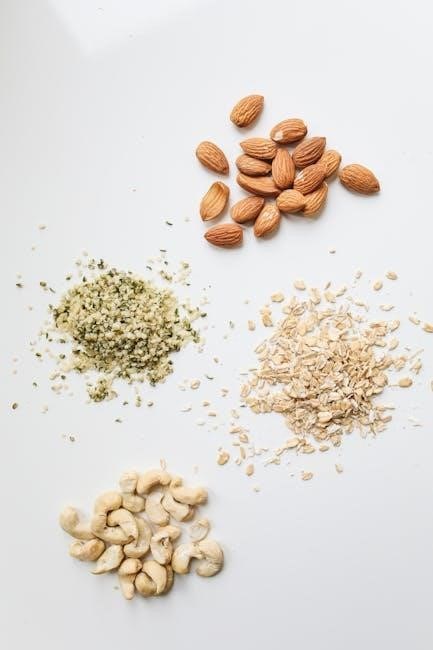
Foods to Avoid in a Low-Fat Diet
Processed Foods
Fried Foods
High-Fat Snacks
Red Meat
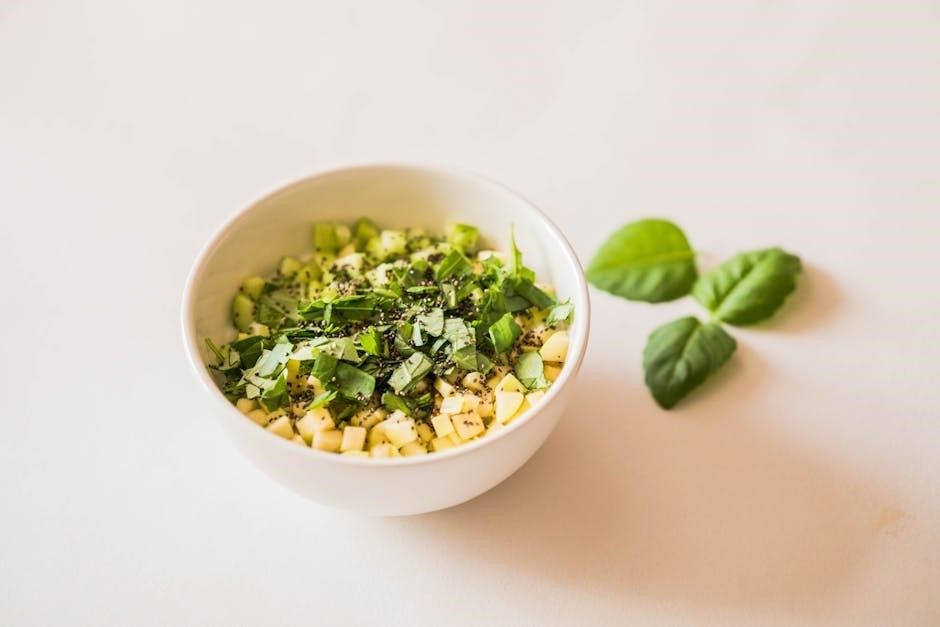
Cooking Methods for a Low-Fat Diet
Grilling and Roasting
Steaming and Poaching
Baking and Stir-Frying
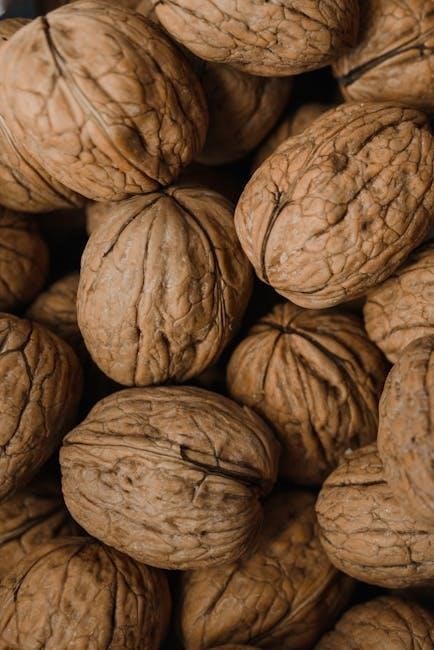
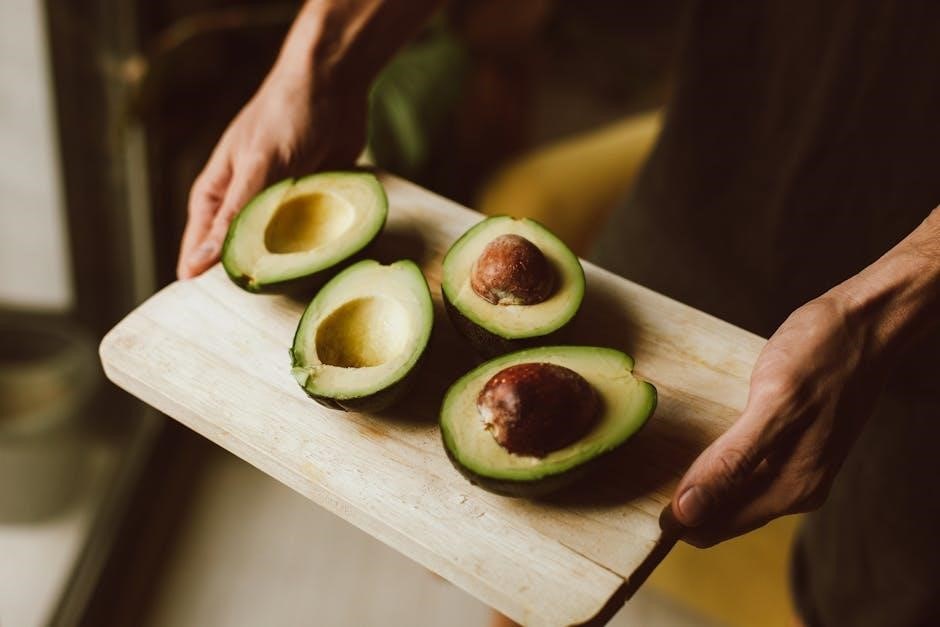
Meal Planning Tips
Breakfast Ideas
Lunch Options
Dinner Choices
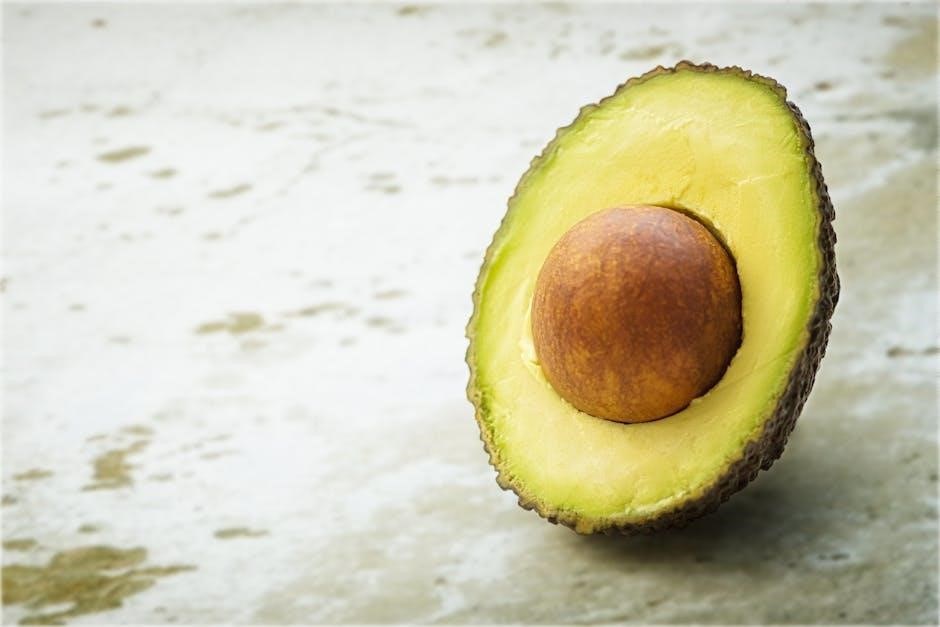
Snacks and Desserts
Low-Fat Snack Options
Healthy Dessert Ideas
The Importance of Portion Control
Staying Motivated on a Low-Fat Diet
